Welcome to GREEN
TEA TIME
Hiroshi Takahashi and Silent Giants
various places of Japan
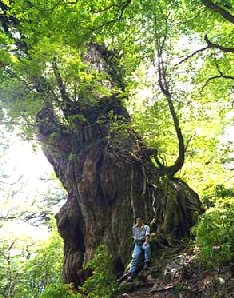 Hiroshi Takahashi is a photographer who has been fascinated by ancient trees and visited many places across Japan to take their photos. His photos of these majestic trees have been used for company calendars of leading firms and various media. Hiroshi kindly wrote an essay to this site. This essay is about his deep affection towards those silent giants and his enthusiasm about his work.
Hiroshi Takahashi is a photographer who has been fascinated by ancient trees and visited many places across Japan to take their photos. His photos of these majestic trees have been used for company calendars of leading firms and various media. Hiroshi kindly wrote an essay to this site. This essay is about his deep affection towards those silent giants and his enthusiasm about his work.
(Takahashi and the most renowned Japanese Red Cedar (Cryptomeria japonica). 'Jomon Sugi (Jomon Cedar)', as nicknamed, is a UNESCO World Heritage as well as a National Monument of Japan and grows in Yakushima Island, offshore Kyushu. These days,to prevent visitors' pressure such as soil compaction and erosion, the tree can be seen from a newly-built viewing point. Carrying a handful of soil in the island to the tree is an established custom among visitors to restore eroded soil.)
To email him please click here!

Until the Day I Photograph the 2000th Giant Tree of Japan
Hiroshi Takahashi, Photographer,
Tokyo, Japan
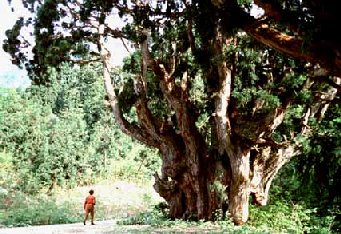 I have taken photographs of giant trees in Japan for 12 years, and have visited about 1500 individuals. Japan is not a big country, but there seems to have been few people who have traveled all over the country to take photographs of giant trees, and although there are many websites on local giants, few sites are comprehensive and systematic about giant trees across Japan like mine.
I have taken photographs of giant trees in Japan for 12 years, and have visited about 1500 individuals. Japan is not a big country, but there seems to have been few people who have traveled all over the country to take photographs of giant trees, and although there are many websites on local giants, few sites are comprehensive and systematic about giant trees across Japan like mine.
(photo: A Japanese Red Cedar (Cryptomeria japonica) named 'Dou Sugi' with its girth 8.73m. Toyama Prefecture, Western-coast Honshu.)
Since I started my web site, I have received offers from a leading electric company for its company calendar as well as various publications for their feature articles and cover pages, and I am pleased that people are getting more and more conscious of nature and wildlife through my photographs.
My interest in giant trees dates back to 13 years ago, when I met a painter who was painting giant trees for his target of 2000 paintings. Impressed by his enthusiasm, I made up my mind to photograph 2000 giant trees. Since then, I have traveled across Japan to visit giant trees and achieve my goal.
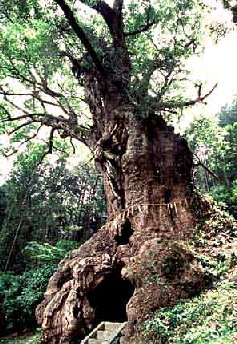 The more giant trees I visited and photographed, the more I was fascinated and intrigued by their mysterious but wonderful properties which by far surpass our common perception. Giant trees are full of overwhelming vitality and a majestic air, and at the same time they possess some invisible power of impressing and soothing us. To record such giants, I take photographs one by one, day by day, to achieve my goal of 2000 different trees. However, due to pests and diseases, and also to air pollution, these days I often find in deep sorrow that some trees I visit again to say Hi! have died and been removed, only leaving their massive stumps, reminiscent of their past glory. It is a very disappointing and heart-breaking moment.
The more giant trees I visited and photographed, the more I was fascinated and intrigued by their mysterious but wonderful properties which by far surpass our common perception. Giant trees are full of overwhelming vitality and a majestic air, and at the same time they possess some invisible power of impressing and soothing us. To record such giants, I take photographs one by one, day by day, to achieve my goal of 2000 different trees. However, due to pests and diseases, and also to air pollution, these days I often find in deep sorrow that some trees I visit again to say Hi! have died and been removed, only leaving their massive stumps, reminiscent of their past glory. It is a very disappointing and heart-breaking moment.
(photo: A Kusu (Cinnamomum camphora) in the center of Takeo City, Saga Prefecture, Northern Kyushu)
Because of their size, giant trees look very stout and strong. However, in reality they are very delicate and susceptible to subtle environmental changes - this is what I have learned through my exchange with these giants via my camera lens. As a member of the Society for Giant Trees, organized by the painter, I join projects to protect giant trees such as fitting a bonding equipment and lightning rod to them to prevent lightening damage. The society also organizes tree planting projects and giant tree survey. It was a memorable moment when I shared excitement and joy with other members when we found record-breaking giants of Japanese Beech (Fagus crenata) and Japanese Sweet Chestnut (Castanea crenata). When I achieve my goal of photographing 2000 giant trees, I will set a new target of 3000, and hopefully visit giant trees overseas.
- GENERAL INFORMATION ON CLIMATIC CONDITIONS OF JAPAN AND ITS GIANT (ANCIENT) TREES -
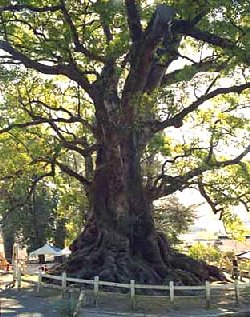 Japan is a volcanic archipelago with about 70% of its total land, most of which mountainous, covered with woodland and forestry plantation. With relatively small area of its land, Japan has four climates - sub-boreal, temperate, alpine and sub-tropical, and most of is regions it has four distinctive seasons. Temperate regions, which occupy most of its land, and also sub-tropical regions, enjoy relatively warm temperatures and sufficient precipitation to enable a great variety of tree species to live long and become giants.
Japan is a volcanic archipelago with about 70% of its total land, most of which mountainous, covered with woodland and forestry plantation. With relatively small area of its land, Japan has four climates - sub-boreal, temperate, alpine and sub-tropical, and most of is regions it has four distinctive seasons. Temperate regions, which occupy most of its land, and also sub-tropical regions, enjoy relatively warm temperatures and sufficient precipitation to enable a great variety of tree species to live long and become giants.
(photo: A Kusu (Cinnamomum camphora) in Kamou City, Kagoshima Prefecture, Southern Kyushu.)
Among our native trees, Kusu (Cinnamomum camphora), Japanese Red Cedar (Cryptomeria japonica), Keyaki(Keaki) (Zelkova serrata), Edo-higan Cherry (Prunus pendula form. ascendens), and Katsura Tree (Cercidiphyllum japonicum) tend to live long and become massive. Among these, Kusu, an evergreen broadlieved tree which belongs to the family Lauraceae, tends to grow its stem thickest of all native trees. It is considered that the thick stem and relatively short height is to deal with strong gales in typhoon.
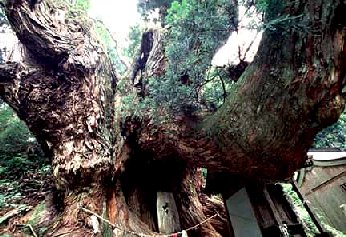 On the contrary, Japanese Red Cedar, a little brother of California Redwood (Sequoia sempervirens) and Wellingtonia (Sequoiadendron giganteum), grows tallest among our native trees, and the champion tree as far as I have measured is 62m tall, and many giant Japanese Red Cedars are considered well more than 1000 years old. Japanese Red Cedar is an endemic species to the country, and with its cultural association with the people throughout their history, it is undoubtedly 'the tree of Japan'.
On the contrary, Japanese Red Cedar, a little brother of California Redwood (Sequoia sempervirens) and Wellingtonia (Sequoiadendron giganteum), grows tallest among our native trees, and the champion tree as far as I have measured is 62m tall, and many giant Japanese Red Cedars are considered well more than 1000 years old. Japanese Red Cedar is an endemic species to the country, and with its cultural association with the people throughout their history, it is undoubtedly 'the tree of Japan'.
(photo: A Japanese Red Cedar (Cryptomeria japonica) with its girth of 17m. Fukui Prefecture, Western-coast Honshu.)
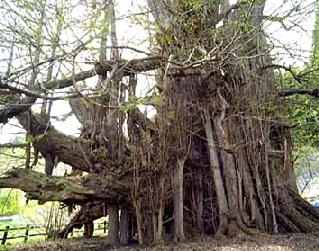 Maidenhair Tree (Ginkgo biloba), native to China and introduced to Japan in a very early stage of our history, grows quite happily in our climates, and there are many giants across the country. The most massive one boasts its girth exceeding 20m (Maindenhair Tree of Kita Kanegasawa - photo), and I consider that it is one of the most colossal Ginkgo's in the world.
Maidenhair Tree (Ginkgo biloba), native to China and introduced to Japan in a very early stage of our history, grows quite happily in our climates, and there are many giants across the country. The most massive one boasts its girth exceeding 20m (Maindenhair Tree of Kita Kanegasawa - photo), and I consider that it is one of the most colossal Ginkgo's in the world.
(photo: Maindenhair Tree (Ginkgo biloba) of Kita Kanegasawa, Aomori Prefecture, Northern Honshu.)
Hiroshi Takahashi is a professional photographer. Copyright of all images in this page as well as text belong to Hiroshi Takahashi. Text translated by Mari Sato.
To contact Hiroshi Takahashi about his photographic work as well as for any comments
on his essay, please click here.
To meet more ancient trees in Japan, please click here to visit Takahashi's site.
(Japanese only, but just looking at photos will be quite enjoyable.)

- COMMENTS FROM MARI -
When I first visited Hiroshi's massive website on giant trees of Japan, I was virtually overwhelmed by massive trees coming one after another, region after region, species after species....
To translate his essay into English, I deliberately kept the original meaning of the Japanese word 'giant tree', because we normally call ancient(or veteran) trees 'kyoju' or 'kyoboku', meaning 'giant tree'(while in some countries of the north-east Asia, such as Taiwan, they use the term meaning 'ancient tree').
I am afraid that people from the North America would laugh, saying, 'Giants? 62m is no giant when you see our redwoods!', and if you are from India you would also ridicule the size of Japanese giants, mentioning cathedral-like banyan trees.... British people would claim the very long lifespan of their pollarded oaks, or yews with unmeasurable age.
One thing common to all these ancient trees, no matter their sizes, is in every corner of the world there exist ancient trees of the region, possessing an awe-inspiring air about them making every visitor feel shrunk. This is because they are survivors of today, originally germinating from a seed, growing slowly but never beaten by any challenge, always staying there witnessing history of humans generation after generation.... But one must admit that someday such veterans will subsequently succumb to their age, and in this respect Hiroshi's work to record such trees in photography is invaluable.
It is also true that a tree can regenerate in various ways. Its lower branches may touch the ground and take root to form young trees around the parent tree. Studies have shown that seedlings germinating from acorns and seeds dropped near a parent tree can be linked to their parent underground by means of mycelium (a network of fungal strands) of beneficial fungi (mycorrhizal fungi) which transport nutrients to the young trees growing under the shade of their parent. One day their parent will go, and one of the youngsters will become its successor. We should think about various types of direct and indirect damage (such as pollution and wrong tree care practice and also ignorance etc.) to trees and make efforts to minimize them so they can regenerate and show us more their wonders.
I am very grateful to Hiroshi for kindly writing the essay and allowing me to use these fantastic images.
I hope further success of his work and health and well-being of these silent giants!

Copyright except for the text and images by Hiroshi Takahashi (C) 2000 Mari Sato All rights reserved.
 Hiroshi Takahashi is a photographer who has been fascinated by ancient trees and visited many places across Japan to take their photos. His photos of these majestic trees have been used for company calendars of leading firms and various media. Hiroshi kindly wrote an essay to this site. This essay is about his deep affection towards those silent giants and his enthusiasm about his work.
Hiroshi Takahashi is a photographer who has been fascinated by ancient trees and visited many places across Japan to take their photos. His photos of these majestic trees have been used for company calendars of leading firms and various media. Hiroshi kindly wrote an essay to this site. This essay is about his deep affection towards those silent giants and his enthusiasm about his work.  I have taken photographs of giant trees in Japan for 12 years, and have visited about 1500 individuals. Japan is not a big country, but there seems to have been few people who have traveled all over the country to take photographs of giant trees, and although there are many websites on local giants, few sites are comprehensive and systematic about giant trees across Japan like mine.
I have taken photographs of giant trees in Japan for 12 years, and have visited about 1500 individuals. Japan is not a big country, but there seems to have been few people who have traveled all over the country to take photographs of giant trees, and although there are many websites on local giants, few sites are comprehensive and systematic about giant trees across Japan like mine.  The more giant trees I visited and photographed, the more I was fascinated and intrigued by their mysterious but wonderful properties which by far surpass our common perception. Giant trees are full of overwhelming vitality and a majestic air, and at the same time they possess some invisible power of impressing and soothing us. To record such giants, I take photographs one by one, day by day, to achieve my goal of 2000 different trees. However, due to pests and diseases, and also to air pollution, these days I often find in deep sorrow that some trees I visit again to say Hi! have died and been removed, only leaving their massive stumps, reminiscent of their past glory. It is a very disappointing and heart-breaking moment.
The more giant trees I visited and photographed, the more I was fascinated and intrigued by their mysterious but wonderful properties which by far surpass our common perception. Giant trees are full of overwhelming vitality and a majestic air, and at the same time they possess some invisible power of impressing and soothing us. To record such giants, I take photographs one by one, day by day, to achieve my goal of 2000 different trees. However, due to pests and diseases, and also to air pollution, these days I often find in deep sorrow that some trees I visit again to say Hi! have died and been removed, only leaving their massive stumps, reminiscent of their past glory. It is a very disappointing and heart-breaking moment.
 Japan is a volcanic archipelago with about 70% of its total land, most of which mountainous, covered with woodland and forestry plantation. With relatively small area of its land, Japan has four climates - sub-boreal, temperate, alpine and sub-tropical, and most of is regions it has four distinctive seasons. Temperate regions, which occupy most of its land, and also sub-tropical regions, enjoy relatively warm temperatures and sufficient precipitation to enable a great variety of tree species to live long and become giants.
Japan is a volcanic archipelago with about 70% of its total land, most of which mountainous, covered with woodland and forestry plantation. With relatively small area of its land, Japan has four climates - sub-boreal, temperate, alpine and sub-tropical, and most of is regions it has four distinctive seasons. Temperate regions, which occupy most of its land, and also sub-tropical regions, enjoy relatively warm temperatures and sufficient precipitation to enable a great variety of tree species to live long and become giants.  On the contrary, Japanese Red Cedar, a little brother of California Redwood (Sequoia sempervirens) and Wellingtonia (Sequoiadendron giganteum), grows tallest among our native trees, and the champion tree as far as I have measured is 62m tall, and many giant Japanese Red Cedars are considered well more than 1000 years old. Japanese Red Cedar is an endemic species to the country, and with its cultural association with the people throughout their history, it is undoubtedly 'the tree of Japan'.
On the contrary, Japanese Red Cedar, a little brother of California Redwood (Sequoia sempervirens) and Wellingtonia (Sequoiadendron giganteum), grows tallest among our native trees, and the champion tree as far as I have measured is 62m tall, and many giant Japanese Red Cedars are considered well more than 1000 years old. Japanese Red Cedar is an endemic species to the country, and with its cultural association with the people throughout their history, it is undoubtedly 'the tree of Japan'.  Maidenhair Tree (Ginkgo biloba), native to China and introduced to Japan in a very early stage of our history, grows quite happily in our climates, and there are many giants across the country. The most massive one boasts its girth exceeding 20m (Maindenhair Tree of Kita Kanegasawa - photo), and I consider that it is one of the most colossal Ginkgo's in the world.
Maidenhair Tree (Ginkgo biloba), native to China and introduced to Japan in a very early stage of our history, grows quite happily in our climates, and there are many giants across the country. The most massive one boasts its girth exceeding 20m (Maindenhair Tree of Kita Kanegasawa - photo), and I consider that it is one of the most colossal Ginkgo's in the world.